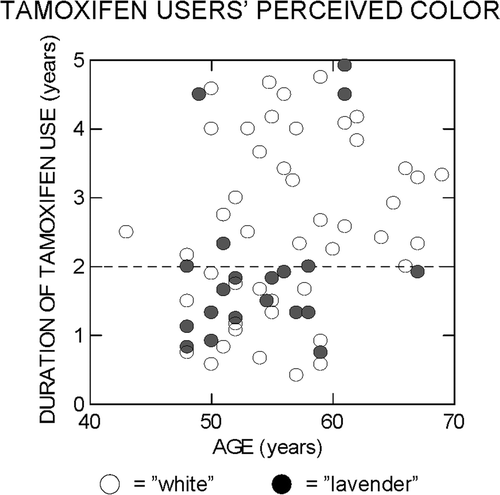Figures & data
FIGURE 1 Duration of tamoxifen use versus age for the amenorrheic tamoxifen users tested with the forced-response color-naming paradigm detailed in Eisner et al. (2006).Citation184 Open symbols represent subjects who called the threshold-level incremental test stimulus “white”, and filled symbols represent subjects who called this stimulus “lavender”. The test stimulus was a 3° diameter short-wavelength (440 nm) disc that was square-wave modulated at a rate of 1.5 Hz and was centered within an adapting background stimulus. The background was a moderately bright (3.6 log troland) 11° diameter, yellow (580 nm) disc viewed for at least 5 minutes. The horizontal dashed line signifies 2 years of tamoxifen use. (Data from three tamoxifen users who called the stimulus “blue” are omitted. For one of these subjects, the sensitivity was grossly reduced;184 the other two subjects were ages 56.8 and 59.5 years, and used tamoxifen for 4.0 and 4.9 years, respectively.) This graph has not been published previously.

FIGURE 2 Foveal shape profiles normalized to the locus of minimal retinal thickness; nasal direction is to the left, and temporal to the right. Squares (□) represent median data of anastrozole users, circles (○) represent median data of control subjects, and crosses (×) represent median data of tamoxifen users. Connecting lines are unbroken for the anastrozole users and control subjects, and dashed lines are for the tamoxifen users. All units are microns (μm). Note that the scales on the two axes differ. The locus of minimal thickness defines a height of 0 μm on the ordinate. Data are derived from subjects without detectable PVDs. This figure was previously published as in (Eisner et al. Vitreo-retinal traction and anastrozole use. Breast Cancer Res Treat. 2009;117:9–16),Citation181 but with a different legend and title. The graph is reproduced with kind permission from Springer Science+Business Media B.V.
